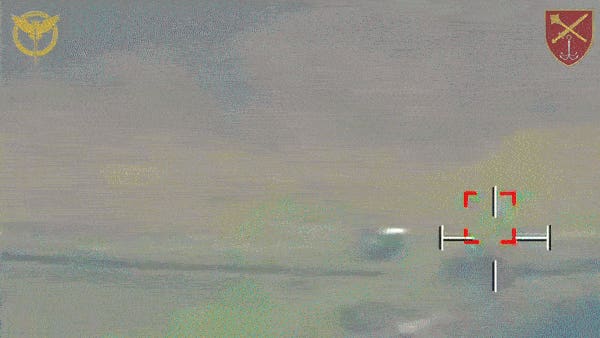For the eighth time in nine months, Russian trainees gathered out in Russian-occupied Ukraine within the range of Ukraine’s best American-made rockets—and those rockets streaked down, inflicting mass casualties.
That Russian commanders continue to conduct training out in the open in broad daylight so close to the front line of Russia’s 33-month wider war on Ukraine speaks to widespread leadership problems in the Russian armed forces—problems that are bound to get worse in the coming weeks as Ukraine intensifies its attacks on officers and their staffs in addition to bombarding troops in training.
On or just before Thursday, around a dozen Russian troops piled out of civilian vans somewhere in Zaporizhzhia Oblast in Russian-occupied southern Ukraine. A Ukrainian drone winged overhead, silently observing. A Ukrainian High-Mobility Artillery Rocket System wheeled, positioned no farther than 57 miles away on the opposite side of the front line, lobbed a single M30/31 rocket.
The rocket struck within yards of the Russian trainees, peppering them and their vehicles with lethal fragments. The drone peered closer—and counted at least five dead or badly wounded trainees.
The strike could have turned out worse for the Russians. The Ukrainian gunners didn’t follow up their initial launch with a follow-on volley—a so-called “double tap”—targeting the Russian survivors, the wounded trainees and any first-responders who raced in to help. A devastating double-tap HIMARS strike in Zaporizhzhia on Sunday may have killed dozens of Russians.
All the same, the death toll is growing startlingly high as Russian commanders continue to expose their training platoons to Ukrainian rockets. In eight strikes since February—some in Zaporizhzhia, others in Donetsk Oblast in the east—Ukrainian batteries have killed hundreds of Russian trainees.
The anti-trainee raids are reminiscent of a separate bombardment campaign the Ukrainians waged against Russian command staffs in Chornobaivka, adjacent to the city of Kherson in southern Ukraine. Russian forces occupied Kherson for much of 2022 until a swift Ukrainian counteroffensive liberated the city that fall.
As a prelude to the counteroffensive, Ukrainian gunners targeted Russian command posts in Chornobaivka 22 times in eight months. “These attacks significantly degraded the Russians’ ability to plan and conduct coordinated operations,” a trio of U.S. Army officers wrote in a 2023 article in Military Review.
“Some suggest the Russian experience at Chornobaivka and elsewhere can be explained by the Russians’ inability to overcome challenges in professionalism, training and communications,” the American officers added.
The repeated attacks on Russian trainees indicate these challenges persist. The Russian military is still struggling to learn from past failures.
It doesn’t help any efforts to reform command processes that the Ukrainians are stepping up their attacks on Russian officers and their staffs. Just a few days after the United States, the United Kingdom and France authorized Ukraine to strike inside Russia with U.S.-, British- and French-made munitions, the Ukrainian air force targeted a command post in western Russia’s Kursk Oblast with a whopping 10 ex-British Storm Shadow cruise missiles.
That raid may have killed a Russian general and wounded a North Korean one. It should go without saying that eliminating senior battlefield leaders, and their combined experience, only worsens an already dire command environment.
If there’s anything that might save the Russians from themselves in the coming months, it could be the January inauguration of U.S. President-elect Donald Trump. Trump has threatened to let the Russians do “whatever the Hell they want” in Europe—and has signaled he may end U.S. aid to Ukraine. That aid has included both the HIMARS launchers and their deadly rockets.
Read the full article here





